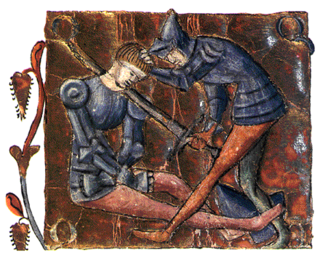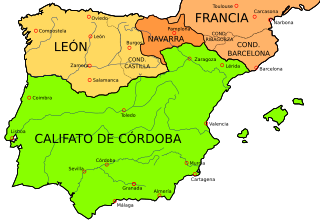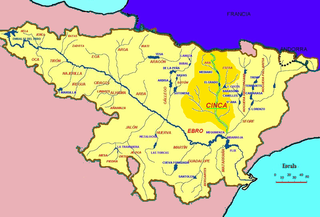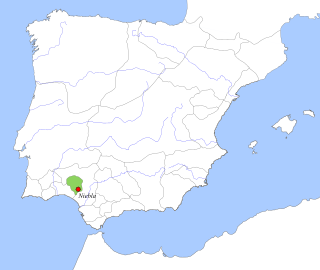 W
WThe Almoravid dynasty was an imperial Berber Muslim dynasty centered in Morocco. It established an empire in the 11th century that stretched over the western Maghreb and Al-Andalus. Founded by Abdallah ibn Yasin, the Almoravid capital was Marrakesh, a city the ruling house founded in 1062. The dynasty originated among the Lamtuna and the Gudala, nomadic Berber tribes of the Sahara, traversing the territory between the Draa, the Niger, and the Senegal rivers.
 W
WThe Battle of Bairén was fought between the forces of Rodrigo Díaz de Vivar, also known as "El Cid", in coalition with Peter I of Aragon, against the forces of the Almoravid dynasty, under the command of Muhammad ibn Tasufin. The battle was part of the long Reconquista of Spain, and resulted in a victory for the forces of the Kingdom of Aragon and the Kingdom of Valencia.
 W
WThe Banu Sumadih were an 11th-century Arab dynasty that ruled the Moorish Taifa of Almería in Al-Andalus. The family also produced several renowned poets, including Umm Al-Kiram.
 W
WThe Battle of Alcoraz took place in 1096 outside Huesca, pitting the besieging forces of Peter I of Aragon and Navarre against the relief forces of Al-Musta'in II of Zaragoza.
 W
WThe Battle of Aqbat al-Bakr was a battle of the Fitna of al-Andalus that took place in the area in and around Espiel, Spain. The battle took place between the forces of the Caliphate of Cordoba, whose forces were commanded by Sulayman ibn al-Hakam, and the Muslim rebel forces of the Catalan-Andalusian alliance trying to overthrow their Caliph overlords under the command of Muhammad ibn Hisham, al-Tagr Al-Awsat and several Christian warlords including Ermengol I, Hugh I, and Ramon Borrell.
 W
WThe Battle of Cabra took place in 1079 in southern Iberia between two Islamic states, Granada and Seville. Each side was aided by Castilian knights under Alfonso VI. It resulted in a victory for El Cid, who routed the invading forces of Emir Abd Allah of Granada and his Christian allies led by Count García Ordóñez. El Cid captured Ordóñez and other Christian knights and held them for three days until releasing them to return to Castile.
 W
WThe Battle of Consuegra was a battle of the Spanish Reconquista fought on 15 August 1097 near the village of Consuegra in the province of Castile-La Mancha between the Castilian and Leonese army of Alfonso VI and the Almoravids under Yusuf ibn Tashfin. The battle soon turned into Almoravid victory and the son of El Cid, Diego Rodríguez, perished. Alfonso, with some Leónese, retreated into the castle of Consuegra, which was besieged for eight days until the Almoravids withdrew to the south.
 W
WThe Battle of Morella, southwest of Tortosa, was fought between Sancho Ramírez, King of Aragon and Navarre, and Yusuf al-Mu'tamin, King of Zaragoza, while the former was engaged in a campaign of conquest against the latter. All surviving sources for the battle are either later by a generation or literary in character, and they are confused on the chronology and dating of the event. The encounter was a defeat for Sancho and sparked a brief reversal of fortunes in the Navarro-Aragonese Reconquista. The Castilian hero, Rodrigo Díaz de Vivar, El Cid, was a general for al-Mu'tamin at the time. According to the Aragonese Crónica de San Juan de la Peña (c.1370), Sancho later sought out El Cid, who had also defeated his father in the Battle of Graus (1063), and defeated him in the year 1088. However, the Crónica is the only source mentioning such an encounter and, as it was written three hundred years later, most leading scholars give no credence to this claim, which was probably intended to justify the prerogatives of Peter IV of the Crown of Aragon.
 W
WThe Battle of Paterna took place between the troops of the Kingdom of Leon, under the command of Ferdinand I of León and Castile, and those of the Taifa of Valencia, commanded by Abd al-Malik ben Abd al-Aziz al-Mansur. The battle occurred at the same time as the Siege of Valencia, resulted in a victory for the Kingdom of Leon.
 W
WOn 25 December 1084, at the Battle of Piedra Pisada, the Taifa of Zaragoza fought and probably defeated the Kingdom of Aragon on the road south from Naval to El Grado. The battle was a minor engagement of the ongoing Reconquista of Aragon, the process by which the riverine valleys of the southern slopes of the Pyrenees were gradually conquered and returned, after centuries of Muslim rule, to the control of Christian princes. The ruler of Aragon, who personally led his men in battle at Piedra Pisada, Sancho Ramírez, also ruled Kingdom of Navarre and was a major figure in the contemporary Reconquista.
 W
WThe Crusade of Barbastro was an international expedition, sanctioned by Pope Alexander II, to take the Spanish city of Barbastro, then part of the Hudid Emirate of Lārida. A large army composed of elements from all over Western Europe took part in the siege and conquest of the city (1064). The nature of the expedition, famously described by Ramón Menéndez Pidal as "a crusade before the crusades", is discussed in historiography, and the crusading element of the campaign is still a moot point.
 W
WThe Fitna of al-Andalus (1009–1031) was a period of instability and civil war that preceded the ultimate collapse of the Caliphate of Córdoba. It began in the year 1009 with a coup d'état which led to the assassination of Abd al-Rahman Sanchuelo, the son of Almanzor, the deposition of the Caliph Hisham II al-Hakam, and the rise to power of Muhammad II of Córdoba, great-grandson of Abd-ar-Rahman III. The conflict would eventually divide all of Al-Andalus into a series of Taifa Kingdoms. The Fitna finally ended with the definitive abolition of the Cordoban Caliphate in 1031, although various successor kingdoms would continue to claim the caliphate for themselves. In addition to the political turmoil, large purges were also carried out by Almanzor throughout his territories. The added pressures of financial collapse were present due to the large tax burden placed on the populace to finance the continuous war.
 W
WThe taifas were the independent Muslim principalities of the Iberian Peninsula, referred to by Muslims as al-Andalus, that emerged from the decline and fall of the Umayyad Caliphate of Córdoba between 1009 and 1031. They were a recurring feature of al-Andalus history. Conquered by the Almoravids in the late 11th century, on its collapse many taifas re-appeared only to be subsumed by the Almohads. The fall of the latter resulted in a final flourishing of the taifas, but by the end of the 13th century only one remained, Granada, the rest being incorporated into the Christian states of the north.
 W
WThe Taifa of Algeciras was a medieval Muslim taifa kingdom in what is now southern Spain and Gibraltar, that existed from 1035 to 1058.
 W
WThe Taifa of Córdoba was an Arab taifa which was ruled by the Banu Jawhar that replaced the Umayyad Caliph as the government of Córdoba and its vicinity in 1031.
 W
WThe Taifa of Granada was a Berber emirate in Al-Andalus, roughly corresponding to the modern province of Granada, Spain, in southern Spain. The emirate originated in 1013 and lasted until 1091.
 W
WThe Taifa of Lérida was a factional kingdom (ṭāʾifa) in Muslim Iberia between 1039/1046 and 1102/1110. Based on the city of Lérida, the ṭāʾifa was not an independent state throughout this period but was sometimes a part of the larger ṭāʾifa of Zaragoza ruled by a governor (wālī).
 W
WThe Taifa of Málaga was an Islamic Moorish taifa kingdom located in what is now southern Spain. It existed during four distinct time periods: from 1026 to 1057, 1073 to 1090, 1145 to 1153, and 1229 to 1239, when the polity was finally conquered by the Emirate of Granada.
 W
WThe Taifa of Niebla was an Arab taifa kingdom that existed during three distinct time periods: from 1023 to 1053, from 1145 to 1150 and from 1234 to 1262.
 W
WThe Taifa of Ronda was a medieval Berber taifa kingdom centered in Moorish al-Andalus in what is now southern Spain. It existed from 1039 to 1065. The taifa was ruled by a family from the Berber Banu Ifran tribe of North Africa. Its capital was the city of Ronda. From 1065 until 1091, the taifa was under the control of the Taifa of Seville, led by Abbad II al-Mu'tadid.
 W
WThe Taifa of Seville was an Arab kingdom which belonged to the Abbadid family. It originated in 1023 and lasted until 1091, in what is today southern Spain and Portugal.
 W
WThe Taifa of Valencia was a medieval Moorish taifa kingdom which existed, in and around Valencia, Spain during four distinct periods: from 1010 to 1065, from 1075 to 1099, from 1145 to 1147 and last from 1229 to 1238 when it was finally conquered by the Aragon.
 W
WViking activity in the Iberian peninsula seems to have begun around the mid-ninth century as an extension of Viking raids on and establishment of bases in Frankia in the earlier ninth century. While connections between the Norse and Eastern Islamic lands were well-established, particularly involving the Rus' along the Volga and around the Caspian Sea, relations with the Western edge of Islam were more sporadic and haphazard. Although Vikings may have over-wintered in Iberia, no evidence has been found for trading or settlement. Indeed, the Iberian peninsula may not have offered particularly wealthy targets, in the ninth to tenth centuries. Sporadic raiding continued until the end of the Viking Age.